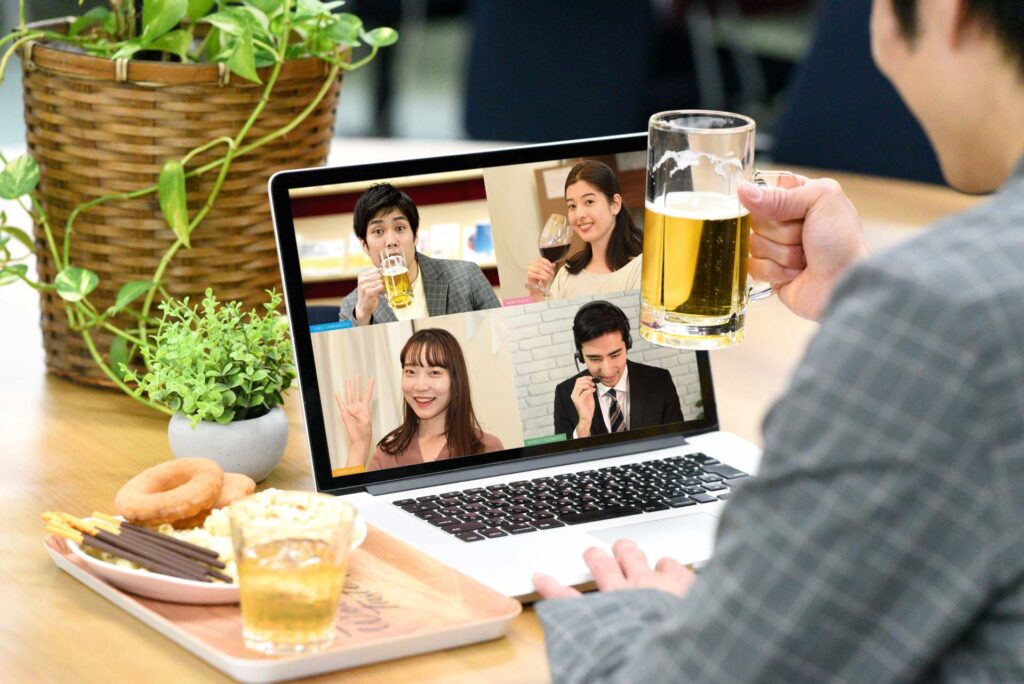When I wake up, one message keeps coming into my email box. “Zoom Nomi (Drinking party on Zoom) will be tomorrow. Please make sure that your PC has the Zoom platform!” On the day of the Zoom Nomi, there were over 30 people on the screen. I saw that each participant held a glass of beer or wine in his/her hand. The event organizer said, “Thank you for joining. Let’s start Zoom Nomi with Kanpai (Cheers)!” The participants held their drinks high in front of their PCs and participated in the toast. Then, we started talking and laughing without interruption, as if Covid-19 could not stop the flood of our emotions.
How to Socialize While Keeping “Social Distancing”?
The COVID-19 pandemic impacts our lives very much. One of them is our socialization. We try to keep social distancing to prevent the spread of the virus. However, we cannot convince ourselves to avoid interactions with others. Meeting people in person is critical to relationship building in Japan. So, people are trying to find a way to keep connected with people without- or at least minimum human connection while maintaining physical distancing from people outside the home.
Go Online for Nomikai
One of the quick solutions for socializing without face-to-face interactions is meeting people online. Now, online drinking parties are flourishing. Instead of Izakaya (Japanese bars) or restaurants, online platforms such as Zoom and LINE facilitate their get-togethers in front of PC screens. As a result, you can find online drinking parties among groups ranging from small friendship circles to 100-strong drinking parties every day.
Besides social distancing, the Online Nomikai offers added values that offline drinking parties do not. The participants do not have to worry about missing trains, selecting their favorite drinks and foods, and going to bed straight after the parties. People are finding that drinking with others over PC screens is not too bad.
Bowing in Micro-Moments
Another tactic that people use for communication without direct interactions is body language. For example, an elderly woman bows without saying any words when meeting a neighbor on the road. People also bow to store clerks at cashiers to express “thank you” without words. The store clerks also bow to their customers as if saying, “You are welcome.”
Bowing helps to convey a greeting or expression of thanks when the face is covered by a mask (a regular situation for many Japanese and even perennial for some). Japanese customarily bow when meeting people, but it facilitates communication without speaking or showing facial expressions.
Connecting People via Hand-Made Masks
Items around us also help to convey our feelings. Due to the shortage of disposable masks at shops, people have started making masks at home to give them as gifts to the health-conscious or needy. For example, schoolgirls make handmade masks and donate them to nursing homes. Mothers make masks with available clothes for their kids. They wear these masks to prevent infection and show appreciation for the people who made them.
Face-to-face interactions are indispensable though
Those mentioned above are temporary solutions to the need to connect, and it doesn’t seem they’ll ever adequately replace face-to-face interactions. People who have attended Online Nomikai still miss the Izakaya because the atmosphere, food, and drinks facilitate close connection. People who wear handmade masks miss direct interactions with the makers. We miss conversations with neighbors and store clerks for sure.
Even after the state of emergency is lifted, social interactions will need to be reduced to prevent the spread of Covid-19. Therefore, we need to continue developing creative solutions for socializing without suppressing direct human interactions.
